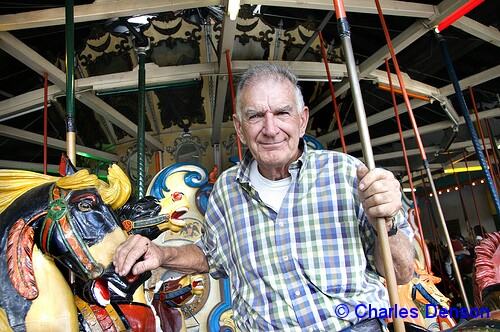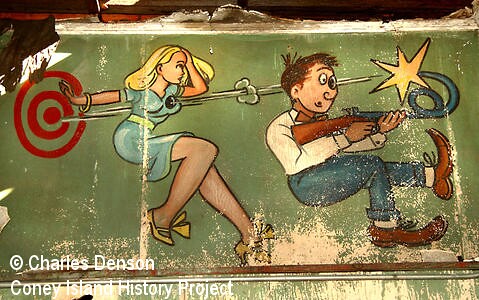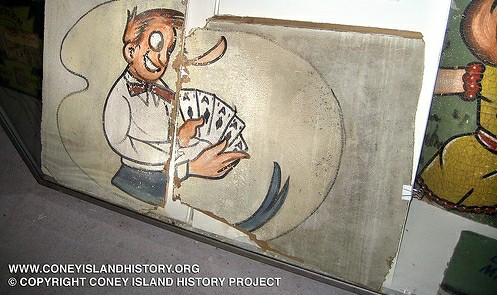Coney Island History Project director Charles Denson rode out Superstorm Sandy in Sea Gate, where his apartment and car were destroyed by the storm surge. On Sunday, September 22, his documentary "The Storm" is premiering at the Coney Island Film Festival. The 20-minute film shows rare and dramatic footage of the storm coming ashore on the evening of October 29, 2012, as well as preparations for the storm, the surge at Coney Island and Sea Gate, and the storm's aftermath. "The Storm" is part of Program 16, featuring several Coney Island-themed films, at 6pm. Tickets are $7. Advance ticket purchase is recommended. The screening venue is Sideshows by the Seashore at Coney Island USA, 1208 Surf Avenue, ground floor. On September 22, prior to the film screening, the Coney Island History Project exhibit center will be open special hours, from 3-5pm. View historic artifacts, photographs, maps, ephemera and films of Coney Island's colorful past. The exhibit center is located on West 12th Street at the entrance to Deno's Wonder Wheel Park. Admission is free of charge.
When Jimmy McCullough visited the History Project to sit for an interview a few years back, I felt that I was in the presence of Coney royalty. He was a man of few words, quiet and hardworking and, like most of the Coney old-timers, someone who rarely left his business during the season. Jimmy was related to three of Coney's pioneer families: the Tilyous, Stubbmanns, and McCulloughs. When the McCullough's Kiddie Park lease was not renewed by Thor Equities last year, the McCullough's little park on the Bowery was forced to close, becoming another one of Thor's vacant lots in the heart of Coney Island. 2013 is the first year since 1862 that there has not been a Tilyou descendant operating in Coney Island.
Jimmy and his family operated numerous small amusement parks and carousels in Coney Island, including the B&B Carousell, which was purchased by the City in 2005 and returned to Coney's Boardwalk earlier this year. Jimmy was a man of many talents who could build or fix anything mechanical and he knew the amusement business inside and out. He was a friend of the Coney Island History Project and will be sorely missed by all those who knew him and worked with him. His death brings a close to a golden age of Coney Island History --Charles Denson
Charles Denson's interview with Jimmy McCullough is part of the Coney Island History Project's Oral History Archive and may be listened to online here.
Services for Jimmy McCullough will be held this week. The family will receive friends at William E. Law Funeral Home, 1 Jerusalem Ave, Massapequa, NY on Thursday, August 22, 7-9PM and Friday, August 23, 2-4:30PM and 7-9PM. The funeral will be on Saturday, August 24, at 10AM at Maria Regina R.C. Church, 3945 Jerusalem Ave, Seaford, NY.

A bevy of organ grinders from the Automatic Musical Instrument Collectors Association (AMICA) and the Carousel Organ Association of America (COAA) will join the History Day celebration at the Coney Island History Project and Deno's Wonder Wheel Park on Saturday, August 10, from 1pm - 6pm. The rally was curated by Bob Yorburg, a band organ restorer, magician and carousel carver, who performed at the History Project last season and restored Grandma's Predictions for Deno's Wonder Wheel Park.
"Hand cranked organs have appeared throughout the streets of New York and in Coney Island for nearly 100 years," says Yorburg, who explains that cranking the organ moves a bellows that provides air to sound the pipes. A roll of paper with holes punched in it creates the music that you hear. "You would often hear people singing along to the music. This form of entertainment predates all other forms of musical reproduction including radio, television and electronic media. Now, for one day only, we are bringing back these free performances with strolling and stationary organs."
Organ Grinder Lola and Master Bob, originally from Baden-Baden, Germany and now based in the Washington, DC area, will appear on the Dreamland Plaza stage on West 12th Street at 3pm. "We'll perform German Moritaten, 19th century street ballads of broken hearts, murder and mayhem," says Lola. "And, of course, the most famous Moritat of them all, 'Mackie Messer,' gangster rap from 1920s Berlin. Plus other fun sing-along songs in English, like the Ballad of Anne Boleyn! Great fun."
Ian Fraser, age 12, of Staten Island, is one of the youngest members of COAA and will perform on Saturday in Deno's Wonder Wheel Kiddie Park. He is the proud owner of a Celestina Organette, a small hand-cranked organ built in 1881 by the Mechanical Orguinette Co of New York. Ian has performed at band organ rallies at Knoebels, Quassy, Wurlitzer, and Olcott Beach.

Members of the New York chapter of AMICA performing on History Day include Vincent and Maryam Morgan on their Castlewood organ in Deno's Wonder Wheel Kiddie Park; Buzz Rosa and Barbara on their Hofbauer organ and Jerry and Cheryl Maler, also on a German Hofbauer organ, in front of the Coney Island History Project; and Bill and Rita Sharkey with their Jager & Brommer Organ, alternating with Bob Stuhmer and Walter Kehoe on Accordeon, at Deno's Wonder Wheel Gazebo on the Boardwalk.
"You will hear an art form that all but died a half a century ago," says Yorburg. "It is now experiencing a renaissance that will be shared for free by enthusiasts. These people have restored, built and bought organs that will be shared with the public." Throughout the day, spectators will have the chance to crank some of the organs and experience a thrill from days gone by.
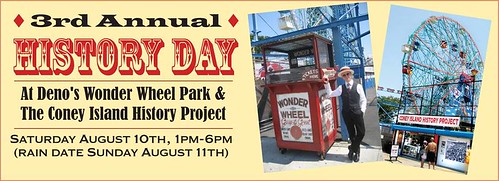
Live Music, Entertainment and History!
Celebrate Historic Coney Island Saturday August 10th from 1pm-6pm by attending the Third Annual HISTORY DAY presented by Deno’s Wonder Wheel Park & The Coney Island History Project, at the new W.12th Street Dreamland Pedestrian Plaza!
History Day festivities include live Ragtime and Dixieland music by the Banjo Rascals, old timey Organ Grinders playing hand cranked musical organs from around the world, Professor Phineas Feelgood's World of Magic, HumanToon/Street Sorcerer Kevin C Carr, and the always amazing Lady Circus! The performances are free to the public and will be held at the Coney Island History Project, the Pedestrian Plaza on 12th Street and in Deno’s Wonder Wheel Kiddie Park. This special event is free and open to the public
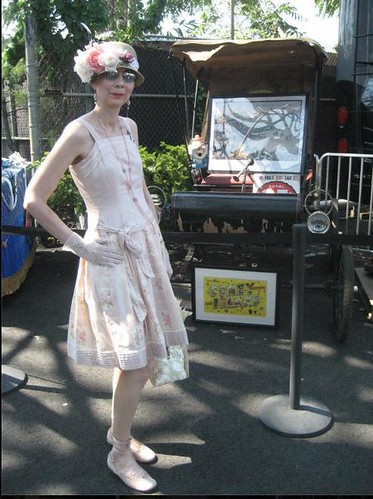
Dress in 1920’s garb and get one free ride on the Wonder Wheel!
Test your Coney Island IQ at the Coney Island Trivia Contest at 2:45PM with historian and author Charles Denson. Prizes include ride passes for Deno's Wonder Wheel Park and souvenir postcards.
If you have a Coney Island story to share, come and record your memories for the History Project's Oral History Archive.
A new exhibit on "The History of Deno's Wonder Wheel: Three Generations" will open on History Day at the Coney Island History Project and continue through September. This exhibit portrays the history of Deno's Wonder Wheel and the Vourderis family who have owned and operated it for three generations. Also on History Day, there will be a presentation about mechanical street organs and the history of organ grinders by band organ builder and restorer Bob Yorburg at the History Project. Admission to the exhibit center is free of charge.

Main Event Locations:
W. 12th Street Dreamland Pedestrian Plaza located between The History Project & The Boardwalk on 12th Street
Deno's Wonder Wheel Park 1025 Boardwalk at Denos D Vourderis Place (W. 12th St) Coney Island, Brooklyn 11224 www.WonderWheel.com
The Coney Island History Project 3059 West 12th Street off the Boardwalk Coney Island, Brooklyn 11224 www.coneyislandhistory.org
Coney Island’s Astrotower was much more than an amusement ride. It served as a symbol of hope. To those of us living in Coney Island in the early 1960s, the tower represented the future of Coney Island, a sign that the neighborhood would survive the city’s urban renewal schemes.
At that time, most of the neighborhood was slated for demolition, and former amusement sites were being converted to housing. Venerable Steeplechase Park closed down the same year that the tower went up. The Albert family took a huge personal risk when they built Astroland and the Astrotower. When the tower was completed in 1964, Coney Island had a bright new landmark proclaiming that the amusement zone would not be wiped away.
The tower was never a thrill ride. It provided an overview, an aerial perspective on Coney Island. The Astrotower was not an ornate or baroque tower like the ones at Dreamland and the old Luna. It was a utilitarian structure, much like Coney’s first tall attraction, the 300-foot Iron Tower, built in the 1870s to resemble a giant oil rig. The Astrotower had idiosyncrasies: it liked to sing and dance, to sway in the wind as the cables hummed a mournful tune. This proved to be its undoing.
Back in the 1970s, when the iconic Parachute Jump was a rusting abandoned relic, there were constant calls for its demolition. But it survived its critics and is now restored as the Eiffel Tower of Brooklyn. The Astrotower would not be so lucky.
When the Coney Island History Project exhibit center opened below the Cyclone in 2007, I got to know the Astrotower’s longtime caretaker, Frank Pugliesi. On Sunday mornings I’d accompany him to the top while he did the weekly maintenance. Frank was an elevator mechanic, and he kept the tower in top shape. The motor room atop the tower looked like new, always clean and freshly painted in bright colors.
Toward the end, some saw the Astrotower as a relic, a leftover that did not belong in the “new” Coney Island. But the truth is that there might not have been a Coney Island for the latest regime to “rescue” if not for the enormous personal investment made by the Albert family in the early 1960s. The tower was a lasting reminder of the optimism that investment represented.
There was a recent plan to decorate the tower with pinwheels and lights, in sync with the new lighting on the Parachute Jump. It would have been beautifully repurposed. But it was not to be, and the Astrotower joins Coney’s towers of the past, a page in history. The tower went out in a dramatic fashion on the Fourth of July weekend 2013 in a fog of hysteria, false rumors, and conflicting reports. It was condemned and cut into pieces and unceremoniously hauled off to a junkyard. Was Hurricane Sandy to blame, or the removal of the observation car and counterweights that always kept it balanced? Or was the tower just trying to escape, its mission accomplished?
The Astrotower cannot be replaced, but another symbol of optimism is waiting in the wings. Now is the time to bring back the Astroland Rocket! --- Charles Denson
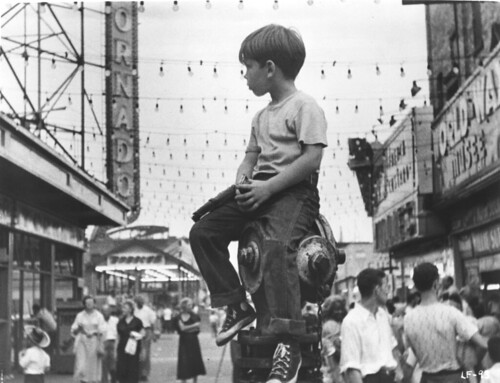
July 1, 2013: TODAY'S 60th ANNIVERSARY SCREENING OF 'LITTLE FUGITIVE" WAS CANCELLED DUE TO RAIN AND IS RESCHEDULED FOR TUESDAY, AUGUST 27.
Join us on July 1 August 27, for a free screening of "Little Fugitive" at Coney Island Flicks on the Beach. The 1953 movie by Morris Engel and Ruth Orkin was filmed in Coney Island on the beach, boardwalk and in the amusement parks, and will be introduced by the directors' daughter Mary Engel. This year is the 60th anniversary of the film, which won the Silver Lion at the Venice Film Festival.
The Coney Island History Project is co-sponsoring the pre-show, which begins at 7:30PM with Coney Poetry presented by Amanda Deutch of PARACHUTE: The Coney Island Performance Festival and a Coney Island history and film trivia contest. Prizes include autographed copies of History Project Director Charles Denson's "Wild Ride: A Coney Island Roller Coaster Family," poetry broadsides from PARACHUTE, and postcards from the Coney Island History Project. Stop by CIHP's tent on the Boardwalk to say hello and learn about our free exhibit center on West 12th Street and oral history archive.
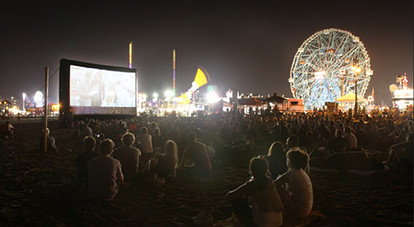
"Little Fugitive," which screens at dusk, stars 7-year-old Joey (Richie Andrusco), who runs away from home to hide out in Coney Island after being tricked into thinking he'd shot his older brother. With his Mom away and with only a few dollars in his pocket, he eats, plays games, rides the carousel and ponies, and collects bottles on the beach and boardwalk to finance more rides.
"Andrusco's chewable little face registers 30 shades of pluck, and codirector Morris Engel's ever-mobile camera casually captures perfection--in sunlight filtering through boardwalk slats, in the quiet descent of the Parachute Jump, in the endlessly repeating pratfalls of the batting cage," writes Eric Hynes in Time Out. "Little Fugitive" is fun for the whole family, and is a perfect time capsule of Coney in the early 50's.
Coney Island Flicks on the Beach are shown at dusk on a jumbo 40-foot screen on the beach at West 10th Street every Monday night through August 19. The free summer series is presented by Rooftop Films in partnership with the Alliance for Coney Island and NYC & Co. "Little Fugitive" is an Artists Public Domain/Cinema Conservancy release. For info about upcoming films, see the schedule in the Coney Island Fun Guide.
"The Curious Playland Arcade Art of Larry Millard" will be on view at the Coney Island History Project from May 25 through Labor Day 2013, Saturdays, Sundays and holidays, from 12 noon-6pm. The exhibit of photo documentation and several examples of original artwork being restored is open to the public free of charge. The History Project's exhibition center is located under Deno's Wonder Wheel Park's iconic entrance sign at 3059 West 12th Street, just a few steps off the Boardwalk.
The mural-covered interior of the Playland Arcade on Coney Island's Surf Avenue delighted patrons for many decades yet few knew the story behind the colorful artwork that covered every inch of the establishment. Playland closed in 1981 and the building stood empty until it was demolished in 2013. The Coney Island History Project's multi-year mission to save and document the unusual murals inside the Playland Building ended successfully on February 14 with the removal of several of Larry Millard's iconic artworks and the remaining letters from the Bowery entrance's neon sign hours before demolition.
Previously saved murals were displayed at the Coney Island History Project's exhibit center last year. We worked with Gateway Demolition to remove several of the murals just before demolition. Our previous efforts at preservation were hampered by trespassers, vandals, black mold, the untimely death of Playland's caretaker, Andy Badalamenti, as well as Superstorm Sandy, but finally the story of the artist who created them can be told. 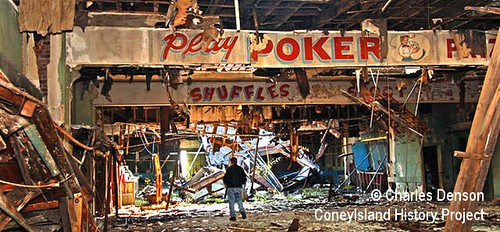
In the winter of 1957 a mysterious unemployed artist named Larry Millard showed up at the Playland Arcade on Surf Avenue looking for work. Forty-five-year-old Millard claimed to have been a cartoonist for the New York Daily News and offered his services as a sign painter. Playland owner Alex Elowitz hired him to paint some small lettered Skeeball signs. His lettering was perfect and he continued working at the arcade through the summer of 1958 painting large and colorful and murals on every inch of wall space.
Millard followed a daily routine, arriving early in the morning unshaven and smelling of alcohol, suffering from the shakes. He was given a couple of bucks for a bottle of Thunderbird wine that he bought at the liquor store across the street next to Mama Kirsh's restaurant. The drink steadied his hand, enabling him to paint.
Stanley Fox, who worked at the arcade owned by his brother, described Millard as "artsy-looking," with dark hair and a mustache, always wearing a Fedora and usually accompanied by his girlfriend, an African-American woman named Eunice. Millard would arrive daily with sketches to be approved by Elowitz. "My brother paid him by the day, maybe $25. Larry lived somewhere in Coney Island, although no one was sure where."
Millard's Skeeball signs led to the complex cartoons he illustrated with puns and jokes: busty, leggy women with hapless boyfriends. Many of his murals were in the cartoon style of Lil' Abner creator Al Capp. The public loved his work and he continued painting Playland until every wall was filled. When Millard finished his murals at the Playland building he began painting outdoor signs around Coney Island, and murals at Stauch's and at the B&B Carousell.
Millard disappeared from Coney Island around 1960 and was never seen again. He left a mark much like native petroglyphs: deceivingly simple yet undecipherable and opaque. His work is mysterious and edgy, erotic and "cartoony." When you look past the inherent humor in his pieces it's possible that most of his sketches were sad self-portraits telling his life story: the portrait of a tortured soul who had bad luck with women. --- Charles Denson
Horace Bullard passed away on April 9th after a long, painful bout with Lou Gehrig's disease. Although he was a controversial figure and I disagreed with him over the years, I believed that his 1980s plan for Coney Island was viable and heartfelt. Horace spent millions of dollars buying property and putting together plans for a major Coney Island amusement park. He remained confident that his plan would come to fruition until a recession and Mayor Rudolph Giuliani ended his dream.
I spent many hours interviewing Bullard for my book, "Coney Island: Lost and Found" and we stayed in touch over the last ten years. Unfortunately, he could not let go of his anger over the loss of his Coney Island lease and his belief that Mayor Giuliani's decision to cancel the lease was racially motivated. Horace became bitter after losing the Steeplechase site and he let his remaining properties, including the Shore Theater and Thunderbolt Roller Coaster, deteriorate. He never fully recovered after Giuliani illegally ordered the demolition of the old coaster in November 2000.
Last spring an interested party representing a popular sports figure contacted me about a plan to buy and restore the Shore Theater and asked me to be the go-between as they were having problems with the negotiations. I agreed to contact Bullard and it seemed that the sale might actually happen. Unfortunately, during this process there were loud calls in the media for the city to take the building using eminent domain. The timing could not have been worse. Bullard was riled and nothing more was said about the plan.
Bullard's grand amusement scheme was bold, audacious and fantastic. Back in the 80s he had investors lined up and the support of the public, the media, and elected officials . He had everything he needed except luck. His decade-long road show kept Coney in the public eye when many had written it off. Bullard's death brings a dramatic but sad chapter of Coney Island history to a close. As his daughter told me, "My dad had such a passion and dream for Coney Island. He was an extraordinary man in so many ways . . ."
– Charles Denson
Coney Island History Project Executive Director Charles Denson visited two classes at PS 226 as part of the Brooklyn Public Library's educational outreach program. The students were completing a year-long project about Coney Island that included debates about development, creating video documentaries, and site visits to the neighborhood. The program was developed by the Brooklyn Public Library's local history division, Brooklyn Connections, which has also invited Denson to speak at a workshop for teachers called "Local History in the Classroom."
"The students were incredible," said Denson. "They were fascinated by Coney Island's history and asked probing questions about development, culture, and the past and future of the community. They were also interested in the techniques of primary source research, which really surprised me." Denson's book, "Coney Island: Lost and Found" was used as the program's textbook. "In the past the Coney Island History Project has worked with local schools PS 188 and Mark Twain, and we hope to expand the history program this year to include local ecology and how climate change will affect Coney Island's future," said Denson.

Missed Opening Day? Visit the Coney Island History Project on Easter, one of Coney's most popular days of the season, to preview our 2013 exhibits. Located on West 12th Street at the entrance to Deno's Wonder Wheel Park, our exhibition center--rebuilt after Superstorm Sandy--will be open from 1 PM to 6 PM on Sunday, March 31. Admission is free for one and all!
You're invited to take a free souvenir photo with the Spook-A-Rama Cyclops seen in the above slide show of Opening Day. This amazing piece of folk art was originally on the roof of Deno's Wonder Wheel Park's 1950s dark ride, which was restored after flood damage from Superstorm Sandy.
This season, the History Project will exhibit films and photos about Sandy's impact on Coney Island. As part of our continuing oral history project we'll be recording personal stories about the storm's aftermath and how it affected the Coney Island community. The public is invited to come to our exhibit center for an audio or video recording, or we can come to your home or business.
Additional exhibits for 2013 include "Coney Island Creek," "The Wonder Wheel: Coney Island's Iconic Amusement Attraction," and "The Curious Art of Larry Millard," an artist whose murals covered the now-demolished Playland Arcade.
The History Project's regular exhibition season is from Memorial Day Weekend through Labor Day. Hours are 12 noon to 6 PM on Saturdays, Sundays and holidays. In the spring, we're open for oral history interviews (by appointment), walking tours (by advance reservation) and special events (TBA). For additional info, e-mail events@coneyislandhistory.org.


